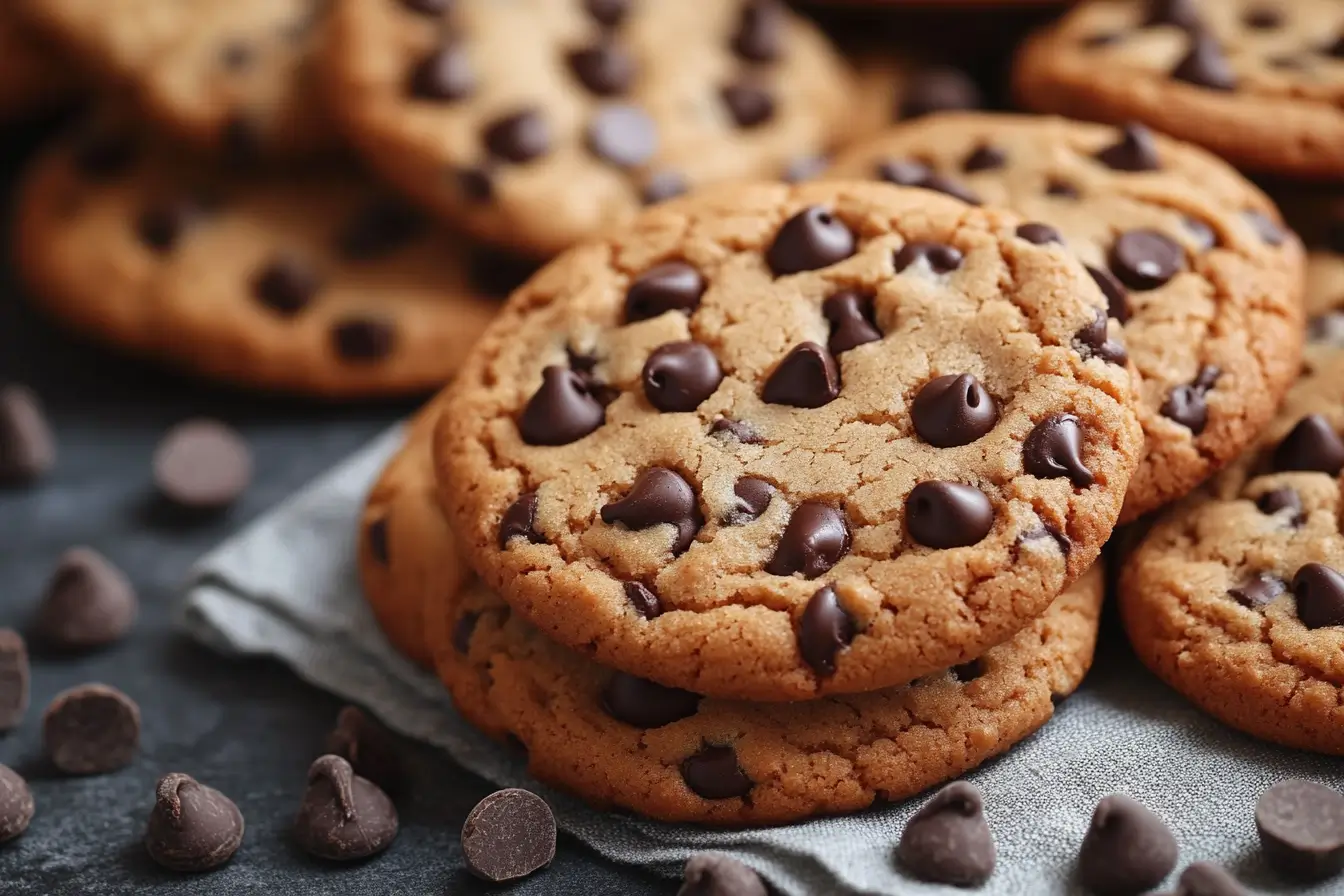Ah, chocolate chip cookies. There’s really nothing better than a warm, gooey cookie fresh out of the oven, right? The scent of butter, sugar, and vanilla wafting through the kitchen—it’s like a hug in food form. But what happens when your chocolate chip cookies go flat and they look more like sad pancakes than the thick, chewy treats you were hoping for? You know, the kind that has a nice, soft center but just the right amount of crisp edges? Yeah, that’s what we’re aiming for. If your cookies are flattening out on you, there’s definitely something off, and it’s driving you bananas!
But don’t worry. You’re not alone in this cookie dilemma. It’s a common issue, and the good news is that there are simple fixes to get those cookies back in shape. I’ve baked countless batches of chocolate chip cookies (some perfect, some flat as a pancake), and I’ve learned a lot along the way. Let’s take a deep dive—oops, sorry, I meant let’s look closely at what could be causing your cookies to go flat, and how you can fix it once and for all.
Too Much Butter—That’s a Big One!
Okay, let’s start with the basics. The thing that gives your cookies that rich, melt-in-your-mouth texture is the butter. But, here’s the kicker: too much butter can make your cookies spread out way too much and end up flat. Why? Well, butter is a fat, and when you bake it, it melts, causing the dough to lose its shape and spread faster than you want.
If you’re using a recipe that calls for, say, 1 cup of butter, and you’ve been generous with the measurements or used melted butter by accident—uh-oh, your cookies might end up flatter than a pancake on a hot griddle. The key here is to measure the butter carefully (no eyeballing it unless you’ve got a pro eye!) and make sure it’s softened, not melted.
Quick Fix:
Cut back on the butter a little. You can even try chilling your dough for 30 minutes before baking. The cooler dough will spread less in the oven.
Not Enough Flour—The Glue That Holds It All Together
Flour is the backbone of your cookie dough, and it’s essential for giving your cookies structure. If you don’t have enough flour in your dough, it won’t hold up well during baking. The result? You guessed it—flat cookies.
It’s easy to skip measuring flour the right way, especially if you’re just scooping it straight out of the container. Here’s the thing, though: that can lead to too little flour being added to the dough, leaving it a little too soft and not thick enough to hold its shape. I’ve been there, and it’s disappointing when your cookies just can’t keep it together.
Quick Fix:
Make sure to measure your flour correctly. Use the spoon-and-level method: spoon the flour into your measuring cup and then level it off with a knife. Also, check your recipe—if you feel like your dough is too soft, add a little more flour until it’s just right!
Baking Soda or Baking Powder Issues
We all know that baking soda and baking powder are the magic behind the rise in most baked goods. But, when it comes to cookies, they play a huge role in keeping them thick and chewy. If you’re not using enough or using old, expired leavening agents, it could be one of the reasons your cookies are flattening out.
Baking soda, in particular, helps cookies spread out just enough, but if you add too much, they’ll spread way too much. And, if your baking powder or soda is expired, it won’t react properly in the oven, which means you could end up with flat cookies that look more like sad, crunchy wafers.
Quick Fix:
Check the expiration date on your baking soda and baking powder! If you have to, replace them. Also, be sure to measure them properly, as too much will cause your cookies to spread, while too little will prevent them from spreading at all (leaving you with dense, weird cookies).
Baking Techniques for the Perfect Cookie, Using a chilled dough is a baker’s best-kept secret. Chilling prevents the dough from spreading too quickly in the oven, helping your cookies maintain their shape. If you’re curious about the age-old debate between crunchy and chewy cookies, check out this discussion for more insights.
Room Temperature Dough (or Not!)
One of the most overlooked steps in cookie-making is the temperature of your dough. If your dough is too warm, it’s going to spread in the oven like nobody’s business. And trust me, nobody wants cookies that end up looking like a puddle.
What’s the trick? You guessed it: chill your dough. Even if you’ve already mixed everything together and you’re itching to bake those cookies, take a breather. Chill that dough for at least 30 minutes to an hour. This helps solidify the fats, keeping the cookies from spreading too much during baking.
Quick Fix:
Chill your dough. I can’t say it enough. Even a short chill in the fridge can help your cookies hold their shape. And if you’ve got extra dough, you can always freeze it for later!
Incorporating the Cream Cheese Filling
The key to creating that luscious, creamy center lies in balancing the cream cheese filling with the dough. Using high-quality cream cheese, softened to room temperature, ensures a smooth and luxurious texture. If you’re wondering whether cream cheese-filled cookies require refrigeration for freshness, you can explore tips in this handy guide.
Overmixing the Dough—Whoops, My Bad!
When I first started baking, I believed mixing more would yield better cookies. Little did I know, overmixing dough is a major culprit when Chocolate Chip Cookies Go Flat. Overmixing activates the gluten in flour excessively, resulting in a tough, overly dense dough that spreads out too much during baking. The key is achieving a delicate balance: mix the dough just enough to combine the ingredients and incorporate the flour, but resist the urge to overdo it. A light hand ensures cookies with a soft, chewy texture and the perfect rise.
Quick Fix:
Mix until the dough comes together. Stop once the ingredients are just incorporated. That’s it. Don’t go overboard unless you want tough cookies. Trust me, I learned this the hard way.
The Wrong Type of Sugar—Yep, It Matters in Cookies
This one caught me off guard when I first learned about it, but it makes sense when you think about it. Different sugars give different results in baking. For chocolate chip cookies, you typically use both white granulated sugar and brown sugar. The brown sugar brings in that caramelized flavor and moisture, which helps prevent the cookies from spreading too thin. White sugar, on the other hand, is more likely to make your cookies crispier.
If you’re only using white sugar, or if your brown sugar isn’t packed tightly enough, you may find your cookies spreading out way more than you want.
Quick Fix:
Stick to the recipe when it comes to sugar types. You can even try switching up the proportions slightly to see what works best. And make sure to pack your brown sugar tightly for the right texture!
Baking Chocolate Chip Cookies Go Flat
Let’s face it: baking sheets matter more than you think. The type of baking sheet you use can affect how your cookies bake. If you’re using a shiny baking sheet, it can reflect too much heat, causing your cookies to spread too much. Darker, non-stick baking sheets tend to absorb heat better, giving you a more even bake.
Also, are you lining your baking sheet with parchment paper? If not, you could be looking at flat cookies that stick to the sheet and spread like crazy.
Quick Fix:
Switch to a dark-colored baking sheet or line your sheet with parchment paper or a silicone baking mat. Both options help prevent excessive spreading and give you nice, thick cookies.
Oven Temperature Isn’t What You Think It Is
How many times have I pulled out cookies, thinking they’re done, only to realize they’re flat and burnt at the edges? Yeah, too many. Sometimes, your oven temperature is off, and that can be why your cookies are spreading. If your oven is too hot, the dough melts too fast and spreads out before it has a chance to set.
Quick Fix:
Get yourself an oven thermometer! They’re not expensive, and they’ll save you from these cookie catastrophes. Preheat your oven properly and, if needed, adjust the temperature a bit lower. Cookies bake best at 350°F, but if you’ve got an oven that runs hot, try 325°F.
To truly impress, experiment with variations like adding a hint of cinnamon or a sprinkle of sea salt for contrast. Need more inspiration? Follow this ultimate guide to baking irresistible chocolate chip cheesecake cookies for professional-level tips and tricks.
Final Thoughts: the Perfect Chocolate Chip Cookies Go Flat
Baking the perfect chocolate chip cookies is a bit like mastering a craft—it takes a little time, patience, and knowing the ins and outs of how ingredients work together. So, next time your cookies decide to go flat on you, remember these tips! From the right amount of butter to measuring flour correctly, and from chilling dough to choosing the perfect baking sheet, you now have the tools to make those perfect, thick, chewy cookies everyone dreams of.
I know it might seem like a lot, but trust me, once you nail it, those cookies will be worth every extra step. So, roll up your sleeves, grab your favorite chocolate chips, and let’s get baking!


1 thought on “Why Do My Chocolate Chip Cookies Go Flat? Simple Fixes”